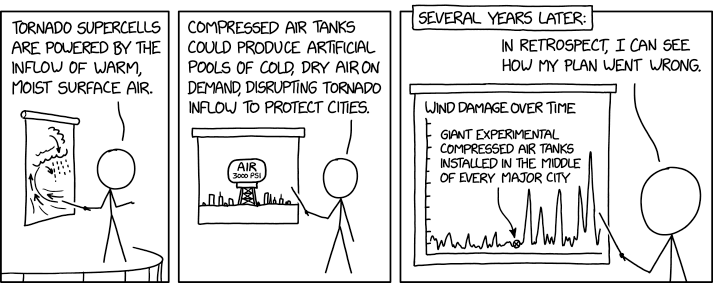Cold Air

We also should really have checked that the old water tower was disconnected from the water system before we started filling it with compressed air.

We also should really have checked that the old water tower was disconnected from the water system before we started filling it with compressed air.
Tornadoes are vortex-driven air columns that rotate at high speeds. The wind speeds can vary from as low as 40 mph (65 km/hr), which is enough to do minor damage to some buildings and trees, to over 300 mph (480 km/hr), which is enough to level buildings, lift houses in the air, and throw automobiles at high speeds. These columns can travel over distances of several miles, causing significant damage and loss of life. Because specific conditions are required for tornado formation, certain regions are particularly prone to tornado activity (such as Tornado Alley in the US). These areas face ongoing threats from tornados, and so detecting and preparing for them is a major concern. The ability to dissipate a tornado before it does any damage would be very valuable.
In this strip, Cueball proposed a method for tornado control. He reasons that, since tornados depend on an inflow of warm, moist air, injecting a flow of cold, dry air should disrupt the cell. In order to protect inhabited areas, he suggests that large tanks of compressed air should be constructed in cities in tornado-prone areas to produce "pools" of cold dry air. The implication is that, if a tornado approaches, the tanks can be used to flood the area with cold air, which would settle near the ground and be drawn up into the tornado, as it approaches, hopefully causing the tornado to disperse.
Whether such a system could potentially work is questionable. For one thing, the volume of air would be so vast, and air movement in such scenarios is so hard to predict, that getting enough cold air into the tornado would be extremely difficult. In addition, it's precisely the mixing of warm and cold air that produces the swirling motion that creates tornadoes. How, exactly, this cold air would interact with the tornado is a matter of speculation. However, the final panel suggests that the plan failed for more basic reasons. Storing the vast quantity of air required would be a massive engineering challenge. The final chart refers to the point where "giant experimental compressed air tanks" are installed in populated areas, and shows that wind damage massively increased after this happened. The implication is that wind damage caused by the tanks themselves far outstripped the effects of tornadoes. The massive, discrete spikes suggest that this is caused by specific, major, damage events.
According to the label on the proposed tank, it would be pressurized to 3,000 psi. Given the scale of the buildings in the picture, the tank must be vast, possibly hundreds of feet in diameter. Simply building a tank that large to hold that kind of pressure would be exceptionally difficult, and any failure would be potentially catastrophic. Any kind of release from the tanks, whether due to valve failure (or accidental opening), pipes failing or being damaged, or the tank itself developing a rupture, would release very high pressure air, potentially at sonic velocities. Given the size of the tank, the amount of air released could be huge, and it would be directly adjacent to buildings, creating high risk of major damage. Because this damage would be done by moving air, it could be considered "wind damage", even though it's artificially generated.An even greater danger would be if the tank were to burst altogether, which is a real danger in pressurized vessels. A sudden and uncontrolled release of air at 3000 psi is effectively an explosion. Given the enormous size of the tank, that explosion would quite certainly be enough to level the surrounding buildings.
The upshot is that, even if this proposal could fulfill its intended purpose (and it's not clear that it would), the risks that it would introduce would massively outweigh any benefits.
In the title text, it is revealed that the water tower they were using to store the compressed air was still plumbed in to the water mains. Given the pressure required for the tower to work properly against tornadoes and the fact that water is nearly incompressible, the pressure from the tower would have been nearly instantly transmitted into the water distribution system. The best case scenario would have been 'just' to have dangerously highly-pressurised water jetting into sinks, bathtubs and toilet cisterns whenever they were used; more severe consequences could be catastrophic failures of pipes and plumbing.
Using technology to disrupt tornadoes before they form was a plot element in Liu Cixin's novel Ball Lightning, and other works. In reality, fringe scientist Prokop Diviš (1698-1765) proposed a weather-control machine to disrupt thunderstorms before they form, and there are occasionally discredited ideas made to control other weather events.